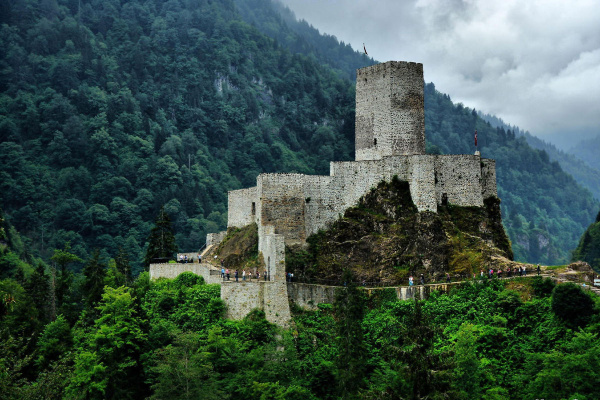YSU researcher Lusine Sahakyan has conducted several studies in Turkey, specifically in the settlements of the present generations of Islamized Hamshens, as well as those of Christian Hamshen Armenians who survived forced Islamization and later dispersed to other countries. She has documented unique folklore and demographic materials, including 2,000 Armenian microtoponyms and dialectal linguistic data.
Lusine Sahakyan, Associate Professor at the Chair of Turkology, Head of the Armenian-Ottoman Relations Department at YSU Institute for Armenian Studies (IAS), has conducted her research within the framework of IAS’s thematic program titled "History, Geographical Distribution, Demographics, and Folklore of the Hamshen Armenians," funded by the Higher Education and Science Committee of MoESCS RA. She visited the provinces of Artvin, Rize, and Erzurum in Turkey, as well as Istanbul, where she met with the descendants of forcibly Islamized Hamshen Armenians. Additionally, she traveled to Krasnodar Krai, Abkhazia, Crimea, and the city of Montebello in California, USA, to meet with the Christian Hamshen Armenians who had settled there.
"The Armenians living in the Hamshen region were forcibly Islamized as early as the 18th century. During the research, I visited some settlements of historic Hamshen, traveled through their villages and highlands, accompanied by intellectual Hamshens, and recorded unique linguistic facts, ethnographic customs, and traditional folk games. Although most of the descendants of the Islamized Hamshens are aware of their Armenian origin, they avoid discussing this topic for various reasons," said Lusine Sahakyan.
She emphasized that, following the forced Islamization policies in Hamshen in the 18th century, although the Hamshens gradually forgot their native language, some Armenian words persisted in their spoken Turkish, particularly in the names of forests, springs, highlands, and small areas. Some even remember their Armenian family names.
Referring to the ancient Armenian words preserved in the dialect of the Islamized Hamshen Armenians, Lusine Sahakyan pointed out, "I recorded these words with great emotion, and I was amazed at how such pure place names and plant names, derived from Classical Armenian, have been preserved in spoken Turkish, maintaining phonetic features unique to the Hamshen dialect. For example, Chermak Chur (meaning 'white water' in Armenian, 'Ճերմակ ջուր'), Dzoveni (from the Armenian place name 'Ծովենի'), Khachivanak (from 'Խաչի վանք', meaning 'Cross Monastery'), Arjovit (from 'Արջհովիտ'), Sokhovit, Khachapit (from 'Խաչափայտ', meaning 'wooden cross'), Balovih, Verjnik, Aghbriap, Dzhemag (from 'Ծմանգ'), and others. As for the plant names, there are morlilig, monut, dzivakhnut, poghbadeni, phughri, peshud, and others."

Regarding the Hamshen Armenians who left their homeland due to forced Islamization in the 18th century and settled in Hopa and Borcka districts of Artvin province, as well as in the villages of Nicomedia, YSU researcher noted that they still speak the Hamshen dialect and continue to create works in this dialect, including songs, poems, and stories. However, over time, Turkish words have permeated their vocabulary.
"Recently, the very popular and beloved song 'Garmi' (meaning 'red' in the Hamshen dialect) is one of the works of the Hamshens from Hopa. Despite speaking the Hamshen dialect, the national identity of these Hamshens is also at risk. They are afraid to speak about their Armenian origin or declare themselves as Hamshen Turks. Only a few intellectual Hamshens openly express their true origin," said Lusine Sahakyan.
She also referred to the history of the Hamshens and noted that those who remained faithful to national values and religion spread along the southeastern shores of the Black Sea, managing to preserve their national identity due to their resistance.
"Starting from the second half of the 19th century, they began to migrate to Abkhazia, Krasnodar Krai, and Crimea. Larger waves of migration occurred during the Hamidian massacres and especially during the Armenian Genocide, continuing until 1923," she stated.
The researcher highlighted that the Hamshen dialect is considered one of the oldest Armenian dialects. She conducted field research in Rize, Artvin, and Istanbul from 2010 to 2013 with the aim of documenting and rescuing the last remnants of Armenian identity among the Islamized Hamshens, which had been forgotten due to generational shifts.

"Today, among the Hamshens who have become Turkish speakers in the Hamshen region, located in the administrative territory of Rize province, nothing remains of their Armenian identity except for the Armenian words in their vocabulary and a few customs. For example, in some areas, they still celebrate Vardavar, which has now turned into a festival of songs and dances. In various conversations, I was told that in the past, families would go up to the highlands, dance in a circle and sing accompanied by the melodies of bagpipe (parkapzuk)," Lusine Sahakyan explained.
According to her, the number of descendants of the forcibly Islamized Hamshens in the region of Hamshen is estimated to be around 60,000. They mostly visit their villages during the summer, as they are mainly dispersed in large cities. Meanwhile, the number of people speaking the Hamshen dialect in Hopa and Borcka is between 42,000 and 45,000. There is an opinion that the total number of Hamshens in Turkey reaches 200,000.
Lusine Sahakyan also pointed out that although the Hamshens converted to Islam, there were very few mosques in their villages. However, after the 1990s, each village built a mosque, and the number of mixed marriages increased, contributing to the assimilation of the Hamshens into Turkish society.
The researcher, by combining the data she collected with the Armenian manuscripts from the 13th to 17th centuries stored at the Matenadaran, the British Museum in London, the Armenian Patriarchate of Jerusalem, the manuscript repositories of the Mekhitarist Congregation in Vienna and Venice, and the Ottoman world geography records held in the Ottoman Archives of the Prime Minister's Office in Istanbul, has written monographs titled "Hamshen in Armenian Manuscripts" in both Armenian and Russian. She has also co-authored a map of Hamshen settlements in the 15th to 17th centuries with cartographer Vardan Mkhitaryan, the Head of the Laboratory for Research on Historical Geography Mapping of Armenia and Key Issues of Armenian Diplomacy named after Harutyunyan. The results of her field research have been presented in the monograph "Hamshen's Microtoponyms" (in Armenian, Russian, French, and Turkish).

In her monographs, Lusine Sahakyan proves that until the 8th century, when the Armenian principality of Hamshen was established, the region was entirely Armenian-inhabited and was one of the properties of the Mamikonyan dynasty, serving as an important spiritual and scholarly center.
"The colophons in the manuscripts written by Hamshen scribes testify that the relics of the Vardanants are buried in the Khachikhor Monastery in the village of Yeghnovit in Hamshen, 'for the protection and pride of the Armenians of the Hamshen region,'" she noted.
In 2013, Lusine Sahakyan's first documentary film "Hamshen at the Crossroads of the Past and Present" won the Armin Wegner Humanitarian Award at the ARPA International Film Festival in Hollywood.
Her second film, "Hamshen in Armenian Manuscripts," which presents the history of Hamshen Armenians, their scribal centers, and cultural features, is now ready. The Russian version of the film has already been shown in Sochi, and the Armenian version will be screened in Yerevan soon.
Nara Martirosyan


